较全英语修辞学方法
英文修辞手法介绍
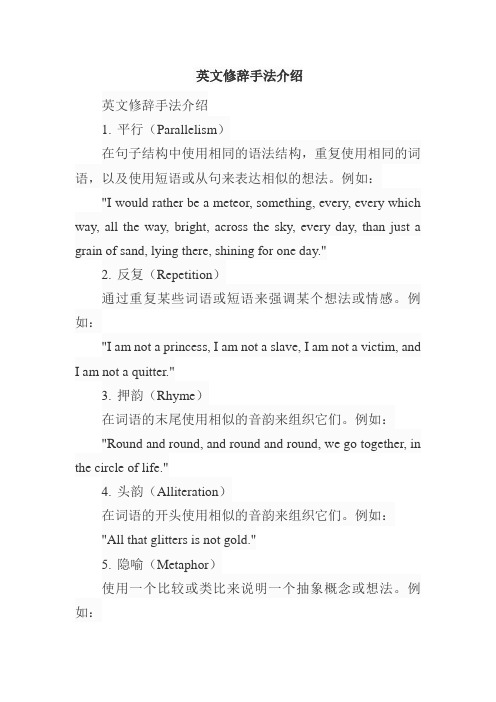
英文修辞手法介绍英文修辞手法介绍1. 平行(Parallelism)在句子结构中使用相同的语法结构,重复使用相同的词语,以及使用短语或从句来表达相似的想法。
例如:"I would rather be a meteor, something, every, every which way, all the way, bright, across the sky, every day, than just a grain of sand, lying there, shining for one day."2. 反复(Repetition)通过重复某些词语或短语来强调某个想法或情感。
例如:"I am not a princess, I am not a slave, I am not a victim, andI am not a quitter."3. 押韵(Rhyme)在词语的末尾使用相似的音韵来组织它们。
例如:"Round and round, and round and round, we go together, in the circle of life."4. 头韵(Alliteration)在词语的开头使用相似的音韵来组织它们。
例如:"All that glitters is not gold."5. 隐喻(Metaphor)使用一个比较或类比来说明一个抽象概念或想法。
例如:"He is a lion in battle."6. 明喻(Simile)使用像“像”或“如同”这样的词语来比较两个不同的事物或概念。
例如:"She sings like a bird."7. 反问(Rhetorical question)使用一个问题来表达一个陈述或观点,而不是提出真正的问题。
(完整word)20种英语修辞手法整理
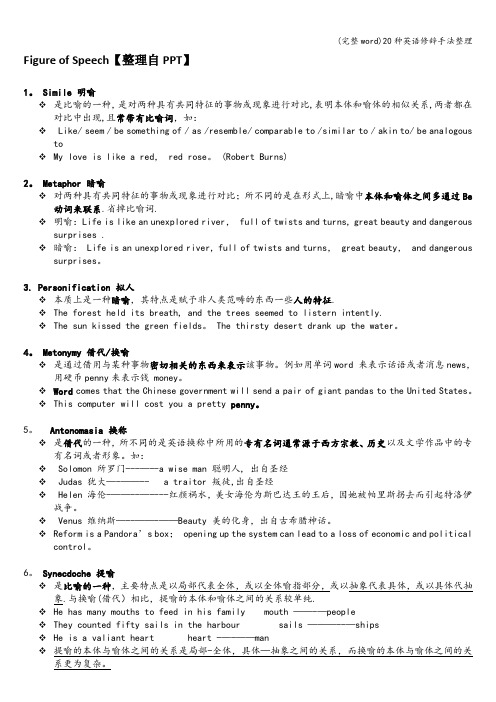
Figure of Speech【整理自PPT】1。
Simile 明喻❖是比喻的一种,是对两种具有共同特征的事物或现象进行对比,表明本体和喻体的相似关系,两者都在对比中出现,且常带有比喻词,如:❖ Like/ seem / be something of / as /resemble/ comparable to /similar to / akin to/ be analogous to❖My love is like a red, red rose。
(Robert Burns)2。
Metaphor 暗喻❖对两种具有共同特征的事物或现象进行对比;所不同的是在形式上,暗喻中本体和喻体之间多通过Be 动词来联系.省掉比喻词.❖明喻:Life is like an unexplored river, full of twists and turns, great beauty and dangerous surprises .❖暗喻: Life is an unexplored river, full of twists and turns, great beauty, and dangerous surprises。
3. Personification 拟人❖本质上是一种暗喻,其特点是赋予非人类范畴的东西一些人的特征.❖The forest held its breath, and the trees seemed to listern intently.❖The sun kissed the green fields。
The thirsty desert drank up the water。
4。
Metonymy 借代/换喻❖是通过借用与某种事物密切相关的东西来表示该事物。
例如用单词word 来表示话语或者消息news,用硬币penny来表示钱 money。
❖Word comes that the Chinese government will send a pair of giant pandas to the United States。
(完整版)英语中的修辞手法
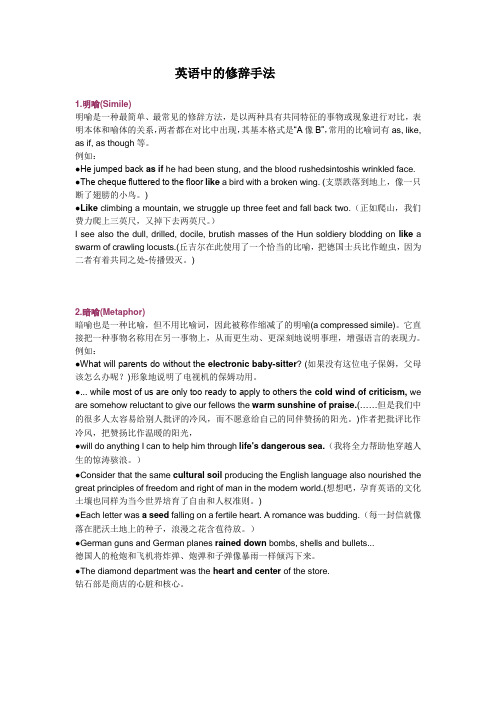
英语中的修辞手法1.明喻(Simile)明喻是一种最简单、最常见的修辞方法,是以两种具有共同特征的事物或现象进行对比,表明本体和喻体的关系,两者都在对比中出现,其基本格式是“A像B”,常用的比喻词有as, like, as if, as though等。
例如:●He jumped back as if he had been stung, and the blood rushedsintoshis wrinkled face.●The cheque fluttered to the floor like a bird with a broken wing. (支票跌落到地上,像一只断了翅膀的小鸟。
)●Like climbing a mountain, we struggle up three feet and fall back two.(正如爬山,我们费力爬上三英尺,又掉下去两英尺。
)I see also the dull, drilled, docile, brutish masses of the Hun soldiery blodding on like a swarm of crawling locusts.(丘吉尔在此使用了一个恰当的比喻,把德国士兵比作蝗虫,因为二者有着共同之处-传播毁灭。
)2.暗喻(Metaphor)暗喻也是一种比喻,但不用比喻词,因此被称作缩减了的明喻(a compressed simile)。
它直接把一种事物名称用在另一事物上,从而更生动、更深刻地说明事理,增强语言的表现力。
例如:●What will parents do without the electronic baby-sitter? (如果没有这位电子保姆,父母该怎么办呢?)形象地说明了电视机的保姆功用。
●... while most of us are only too ready to apply to others the cold wind of criticism, we are somehow reluctant to give our fellows the warm sunshine of praise.(……但是我们中的很多人太容易给别人批评的冷风,而不愿意给自己的同伴赞扬的阳光。
十九种英语修辞手法的详细解释和例句
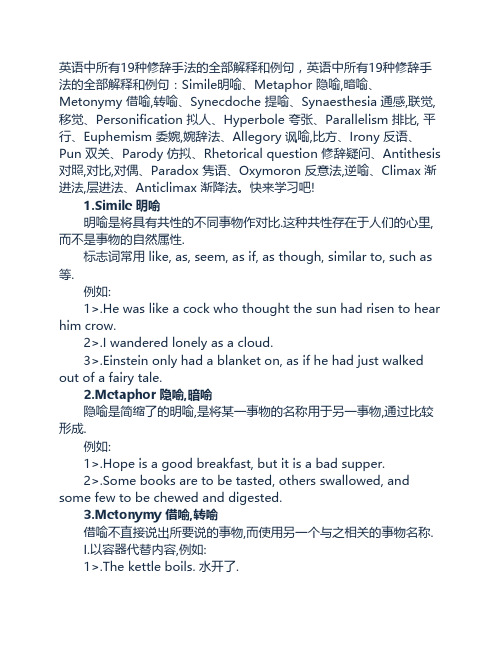
英语中所有19种修辞手法的全部解释和例句,英语中所有19种修辞手法的全部解释和例句:Simile明喻、Metaphor 隐喻,暗喻、Metonymy 借喻,转喻、Synecdoche 提喻、Synaesthesia 通感,联觉,移觉、Personification 拟人、Hyperbole 夸张、Parallelism 排比, 平行、Euphemism 委婉,婉辞法、Allegory 讽喻,比方、Irony 反语、Pun 双关、Parody 仿拟、Rhetorical question 修辞疑问、Antithesis 对照,对比,对偶、Paradox 隽语、Oxymoron 反意法,逆喻、Climax 渐进法,层进法、Anticlimax 渐降法。
快来学习吧! 1.Simile 明喻 明喻是将具有共性的不同事物作对比.这种共性存在于人们的心里,而不是事物的自然属性. 标志词常用 like, as, seem, as if, as though, similar to, such as 等. 例如: 1>.He was like a cock who thought the sun had risen to hear him crow. 2>.I wandered lonely as a cloud. 3>.Einstein only had a blanket on, as if he had just walked out of a fairy tale. 2.Metaphor 隐喻,暗喻 隐喻是简缩了的明喻,是将某一事物的名称用于另一事物,通过比较形成. 例如: 1>.Hope is a good breakfast, but it is a bad supper. 2>.Some books are to be tasted, others swallowed, and some few to be chewed and digested. 3.Metonymy 借喻,转喻 借喻不直接说出所要说的事物,而使用另一个与之相关的事物名称. I.以容器代替内容,例如: 1>.The kettle boils. 水开了. 2>.The room sat silent. 全屋人安静地坐着. II.以资料.工具代替事物的名称,例如: Lend me your ears, please. 请听我说. III.以作者代替作品,例如: a complete Shakespeare 莎士比亚全集 VI.以具体事物代替抽象概念,例如: I had the muscle, and they made money out of it. 我有力气,他们就用我的力气赚钱. 4.Synecdoche 提喻 提喻用部分代替全体,或用全体代替部分,或特殊代替一般. 例如: 1>.There are about 100 hands working in his factory.(部分代整体) 他的厂里约有100名工人. 2>.He is the Newton of this century.(特殊代一般) 他是本世纪的牛顿. 3>.The fox goes very well with your cap.(整体代部分) 这狐皮围脖与你的帽子很相配. 5.Synaesthesia 通感,联觉,移觉 这种修辞法是以视.听.触.嗅.味等感觉直接描写事物.通感就是把不同感官的感觉沟通起来,借联想引起感觉转移,“以感觉写感觉”。
英语18种重要修辞手法

18种重要修辞手法一、语义修辞1明喻(simile)俗称直喻,是依据比喻和被比喻两种不同事物的相似关系而构成的修辞格。
例如:a figure of speech in which denotes a simmilarility betwe en things of different kinds.1.The snow was like a white blanket drawn over the field.2.He was like a cock who thought the sun had risen to hear him crow.认真观察以上各例,我们会发现它们的特点,由(as)... as, like等引导,这些引导词被称作比喻词(acknowledging word),它们是辨别明喻的最显著的特征,明喻较为直白,比喻物和被比喻物之间相似点较为明显,所以明喻是一种比较好判断的修辞手法。
2暗喻(metaphor)也称隐喻,是依据比喻和被比喻两种不同事物的相似或相关关系而构成的修辞格。
例如:a figure of speech in which refers to sth that denotes literally in order to suggest a similarity.1.His friend has become a thorn in his side.(他的朋友已变成眼中钉肉中刺。
)2.You are your mother’s glass.(你是你母亲的翻版。
)3.Hope is a good breakfast, but it’s a bad supper.由以上各例可知,暗喻没有引导词,这是明喻和暗喻在形式上的最大区别。
换句话说,有为明喻,没有为暗喻。
如:He has a heart of stone. He has a heart like stone.很显然,前句是暗喻,后句是明喻。
英语修辞法梳理

英语修辞法梳理-CAL-FENGHAI.-(YICAI)-Company One11. 比喻 (metaphor)比喻就是打比方。
可分为明喻和暗喻:明喻 (simile): A figure of speech in which two essentially unlike things are compared. 明喻:一种修辞手法,把两种基本不相像的东西进行比较.用like, as, as...as, as if(though) 或用其他词语指出两个不同事物的相似之处。
例如:“How like the winter hath my absence been” or “So are you to my thoughts as food to life” (Shakespeare). 如“我的离开好象是冬天来临” 或“你对我的思想就象食物对于生命一样重要” (莎士比亚)O my love's like a red, red rose. 我的爱人像一朵红红的玫瑰花。
The man can't be trusted. He is as slippery as an eel. 那个人不可信赖。
他像鳗鱼一样狡猾。
He jumped as if he had been stung.他像被蜇了似的跳了起来。
Childhood is like a swiftly passing dream. 童年就像一场疾逝的梦。
暗喻 (metaphor):缩写 met., metaph. A figure of speech in which a word or phrase that ordinarily designates one thing is used to designate another, thus making an implicit comparison.用一个词来指代与该词所指事物有相似特点的另外一个事物。
45种英语修辞法

45种英语修辞(最全)(1)alliteration(押头韵):一组单词的第一个辅音相同.When the things happen that you do not like,you have two choices:You get bitter or better(2)metaphor(隐喻):利用某些单词进行含蓄的比喻,此时这些单词已经不再是字面上的意思了,Strawberries flooded the market and prices dropped down.(草莓充斥市场,价格下跌)。
(3)anadiplosis(联珠):将一个或一组单词重复多遍,Men in great place are thrice servants:servants of state,servants of fame,and servants of business.(4)anaphora(首语重复):将一个句子的开头单词或短语,在随后的句子中重复多遍.We shall fight on the seas and oceans,we shall fight on the beaches,we shall fight on the landing grounds,we shall fight in the fields and in the streets,we shall fight in the hills.(5)anastrophe(词序倒装):改变正常词序,比如例句中最后一部分,正常词序是yet a breeze never blew up。
The helmsman steered,the ship moved on,yet never a breeze up blew.(6)antistrophe(逆反复):在每个句子的结尾,重复相同的单词或短语,比如例句中的without warning。
In1931,Japan invaded Manchuria,without warning.In1935,Italy invaded Ethiopia,without warning.In1938,Hitler occupied Austria,without warning.(7)antithesis(对偶):两个或多个句子,结构相同,但含义相反,或者含义形成对比,比如例句中的is no vice与is no virtue。
20种英语修辞手法整理
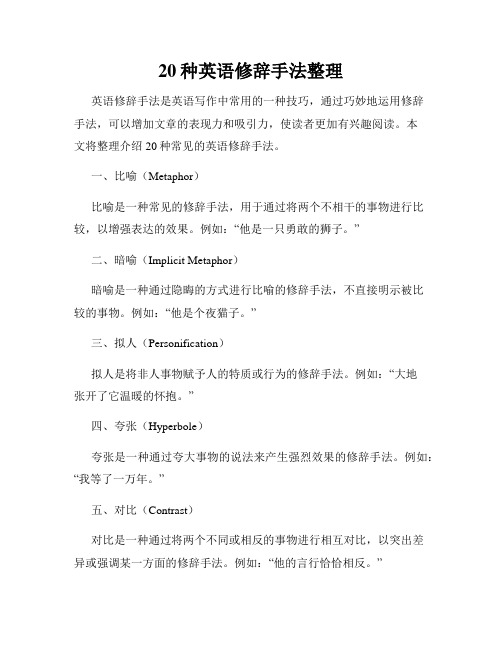
20种英语修辞手法整理英语修辞手法是英语写作中常用的一种技巧,通过巧妙地运用修辞手法,可以增加文章的表现力和吸引力,使读者更加有兴趣阅读。
本文将整理介绍20种常见的英语修辞手法。
一、比喻(Metaphor)比喻是一种常见的修辞手法,用于通过将两个不相干的事物进行比较,以增强表达的效果。
例如:“他是一只勇敢的狮子。
”二、暗喻(Implicit Metaphor)暗喻是一种通过隐晦的方式进行比喻的修辞手法,不直接明示被比较的事物。
例如:“他是个夜猫子。
”三、拟人(Personification)拟人是将非人事物赋予人的特质或行为的修辞手法。
例如:“大地张开了它温暖的怀抱。
”四、夸张(Hyperbole)夸张是一种通过夸大事物的说法来产生强烈效果的修辞手法。
例如:“我等了一万年。
”五、对比(Contrast)对比是一种通过将两个不同或相反的事物进行相互对比,以突出差异或强调某一方面的修辞手法。
例如:“他的言行恰恰相反。
”六、排比(Parallelism)排比是一种通过对句子或短语进行平行结构的修辞手法,以强调重点或增加语句的节奏感。
例如:“奋斗,拼搏,追求,努力。
”七、倒装(Inversion)倒装是一种颠倒语序的修辞手法,常常用于疑问句或为了强调某一部分。
例如:“Never have I seen such a beautiful sunset.”八、反问(Rhetorical Question)反问是一种用疑问句的形式表达肯定或否定的修辞手法,常用于强调某一观点或引起读者思考。
例如:“难道你不想成功吗?”九、比较(Comparison)比较是通过将两个事物进行对比,以凸显共同点或差异的修辞手法。
例如:“学习就像是爬山,充满了艰辛和挑战。
”十、设问(Hypophora)设问是一种在文章中提出问题,并在下文中进行回答的修辞手法,常用于引起读者的关注和思考。
例如:“你知道成功的秘诀是什么吗?答案很简单——努力。
英语22种修辞手法以及例句归纳总结
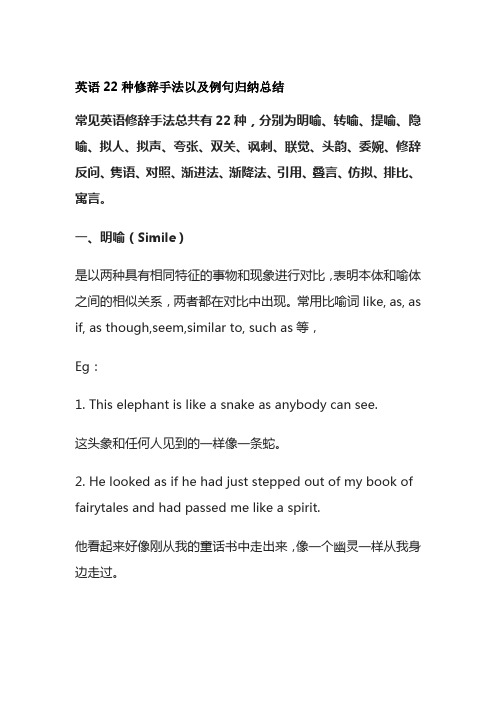
英语22种修辞手法以及例句归纳总结常见英语修辞手法总共有22种,分别为明喻、转喻、提喻、隐喻、拟人、拟声、夸张、双关、讽刺、联觉、头韵、委婉、修辞反问、隽语、对照、渐进法、渐降法、引用、叠言、仿拟、排比、寓言。
一、明喻(Simile)是以两种具有相同特征的事物和现象进行对比,表明本体和喻体之间的相似关系,两者都在对比中出现。
常用比喻词like, as, as if, as though,seem,similar to, such as等,Eg:1. This elephant is like a snake as anybody can see.这头象和任何人见到的一样像一条蛇。
2. He looked as if he had just stepped out of my book of fairytales and had passed me like a spirit.他看起来好像刚从我的童话书中走出来,像一个幽灵一样从我身边走过。
3. It has long leaves that sway in the wind like slim fingers reaching to touch something.它那长长的叶子在风中摆动,好像伸出纤细的手指去触摸什么东西似的。
二、隐喻(Metaphor)这种比喻不通过比喻词进行,而是直接将用事物当作乙事物来描写,甲乙两事物之间的联系和相似之处是暗含的。
Eg:1、The diamond department was the heart and center of the store.钻石部是商店的心脏和核心。
2. He is a pig.他简直是头猪。
(比喻:他是一个像猪一般的人,指肮脏,贪吃的人。
)3. She is a woman with a stony heart.她是一个铁石心肠的女人。
(比喻:这个女人冷酷无情。
)4.Mark Twain is a mirror of America.马克•吐温是美国的一面镜子。
英语13种修辞手法
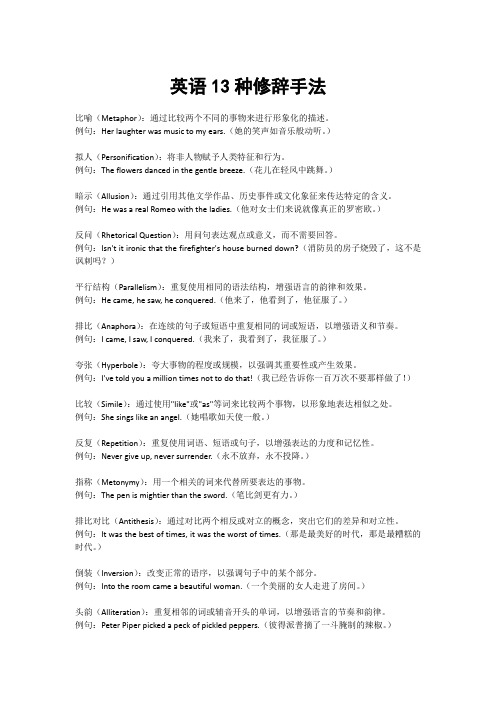
英语13种修辞手法比喻(Metaphor):通过比较两个不同的事物来进行形象化的描述。
例句:Her laughter was music to my ears.(她的笑声如音乐般动听。
)拟人(Personification):将非人物赋予人类特征和行为。
例句:The flowers danced in the gentle breeze.(花儿在轻风中跳舞。
)暗示(Allusion):通过引用其他文学作品、历史事件或文化象征来传达特定的含义。
例句:He was a real Romeo with the ladies.(他对女士们来说就像真正的罗密欧。
)反问(Rhetorical Question):用问句表达观点或意义,而不需要回答。
例句:Isn't it ironic that the firefighter's house burned down?(消防员的房子烧毁了,这不是讽刺吗?)平行结构(Parallelism):重复使用相同的语法结构,增强语言的韵律和效果。
例句:He came, he saw, he conquered.(他来了,他看到了,他征服了。
)排比(Anaphora):在连续的句子或短语中重复相同的词或短语,以增强语义和节奏。
例句:I came, I saw, I conquered.(我来了,我看到了,我征服了。
)夸张(Hyperbole):夸大事物的程度或规模,以强调其重要性或产生效果。
例句:I've told you a million times not to do that!(我已经告诉你一百万次不要那样做了!)比较(Simile):通过使用"like"或"as"等词来比较两个事物,以形象地表达相似之处。
例句:She sings like an angel.(她唱歌如天使一般。
)反复(Repetition):重复使用词语、短语或句子,以增强表达的力度和记忆性。
英文中最常见的20种修辞手法

•
• 2."Of course, you only carry large notes, no small change on you. " The waiter said to the beggar.
• 作者对乞丐说,当然,你只收大钞,所以没零钱啦。
• 12、pun 双关 • 双关就是用一个词在句子中的双重含义、借题发挥、作
the woods. • 我很开心,似乎听到了林中唱歌的鸟儿。
• 7、hyperbole 夸张 • 夸张是以言过其实的说法表达强调的目的。它可以加强语
势,增加表达效果。
• • 举个例子
• 1. I beg a thousand pardons. • 我千百次地祈求宽恕
• 2. Love you. You are the whole world to me, and the moon and the stars.
《My heart leaps up我心雀跃》)
• 17、oxymoron 反意法、逆喻 • • 这也是一种矛盾修辞法,用两种不相调和的特征形容一
个事物,以不协调的搭配使读者领悟句中微妙的含义。 • 往往这样的句子写出来具有很震撼的效果。 • • 例如: • 1. No light, but rather darkness visible. • 没有光,但有看得见的黑暗。 •
•
• 2. If we don't hang together, we shall hang separately.
• 如果我们不团结,就上吊去吧。(注意两个hang意思不 一样)
• 13、parody 仿拟 • 这是一种模仿名言、警句、谚语,改动其中部分词语从
英语最全修辞手法
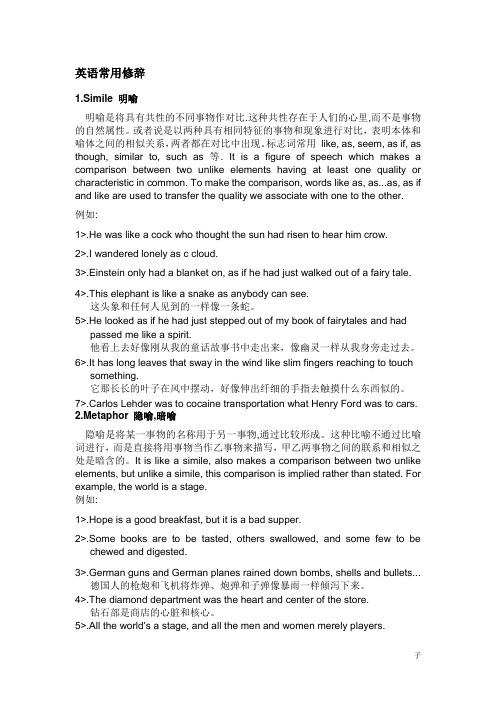
英语常用修辞1.Simile 明喻明喻是将具有共性的不同事物作对比.这种共性存在于人们的心里,而不是事物的自然属性。
或者说是以两种具有相同特征的事物和现象进行对比,表明本体和喻体之间的相似关系,两者都在对比中出现。
标志词常用like, as, seem, as if, as though, similar to, such as等. It is a figure of speech which makes a comparison between two unlike elements having at least one quality or characteristic in common. To make the comparison, words like as, as...as, as if and like are used to transfer the quality we associate with one to the other.例如:1>.He was like a cock who thought the sun had risen to hear him crow.2>.I wandered lonely as c cloud.3>.Einstein only had a blanket on, as if he had just walked out of a fairy tale.4>.This elephant is like a snake as anybody can see.这头象和任何人见到的一样像一条蛇。
5>.He looked as if he had just stepped out of my book of fairytales and hadpassed me like a spirit.他看上去好像刚从我的童话故事书中走出来,像幽灵一样从我身旁走过去。
(完整版)英语修辞法18种
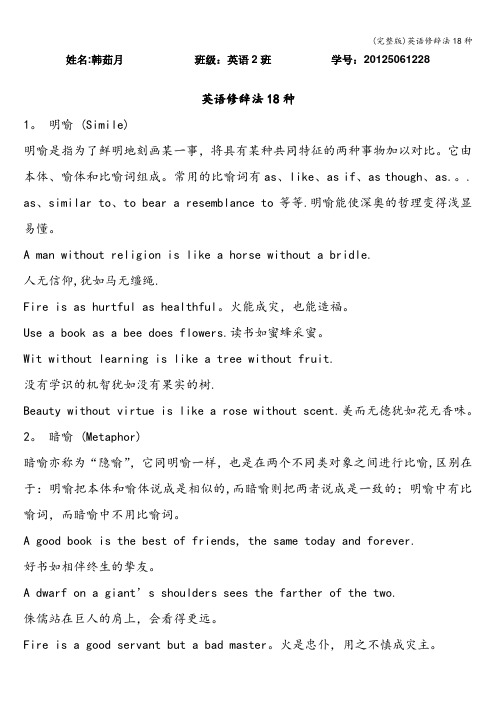
姓名:韩茹月班级:英语2班学号:20125061228英语修辞法18种1。
明喻 (Simile)明喻是指为了鲜明地刻画某一事,将具有某种共同特征的两种事物加以对比。
它由本体、喻体和比喻词组成。
常用的比喻词有as、like、as if、as though、as.。
. as、similar to、to bear a resemblance to等等.明喻能使深奥的哲理变得浅显易懂。
A man without religion is like a horse without a bridle.人无信仰,犹如马无缰绳.Fire is as hurtful as healthful。
火能成灾,也能造福。
Use a book as a bee does flowers.读书如蜜蜂采蜜。
Wit without learning is like a tree without fruit.没有学识的机智犹如没有果实的树.Beauty without virtue is like a rose without scent.美而无德犹如花无香味。
2。
暗喻 (Metaphor)暗喻亦称为“隐喻”,它同明喻一样,也是在两个不同类对象之间进行比喻,区别在于:明喻把本体和喻体说成是相似的,而暗喻则把两者说成是一致的;明喻中有比喻词,而暗喻中不用比喻词。
A good book is the best of friends, the same today and forever.好书如相伴终生的挚友。
A dwarf on a giant’s shoulders sees the farther of the two.侏儒站在巨人的肩上,会看得更远。
Fire is a good servant but a bad master。
火是忠仆,用之不慎成灾主。
A word spoken is an arrow let fly。
出口的话如同离弦的箭。
英语修辞手法总结
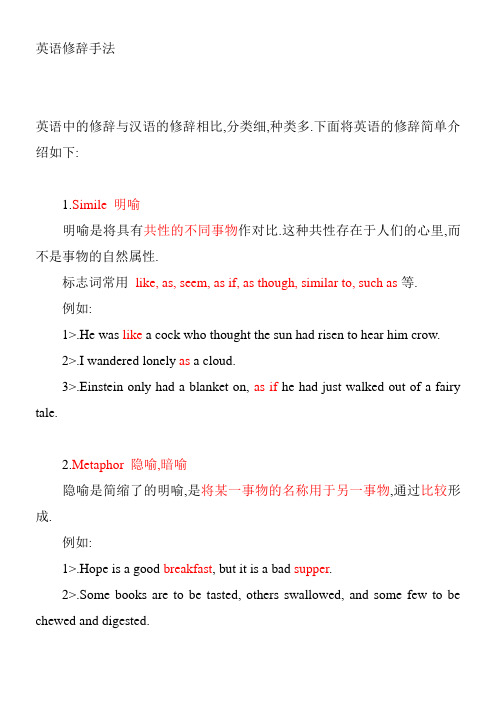
英语修辞手法英语中的修辞与汉语的修辞相比,分类细,种类多.下面将英语的修辞简单介绍如下:1.Simile 明喻明喻是将具有共性的不同事物作对比.这种共性存在于人们的心里,而不是事物的自然属性.标志词常用like, as, seem, as if, as though, similar to, such as等.例如:1>.He was like a cock who thought the sun had risen to hear him crow.2>.I wandered lonely as a cloud.3>.Einstein only had a blanket on, as if he had just walked out of a fairy tale.2.Metaphor 隐喻,暗喻隐喻是简缩了的明喻,是将某一事物的名称用于另一事物,通过比较形成.例如:1>.Hope is a good breakfast, but it is a bad supper.2>.Some books are to be tasted, others swallowed, and some few to be chewed and digested.3.Metonymy 借喻,转喻借喻不直接说出所要说的事物,而使用另一个与之相关的事物名称.I.以容器代替内容,例如:1>.The kettle boils. 水开了.2>.The room sat silent. 全屋人安静地坐着.II.以资料.工具代替事物的名称,例如:Lend me your ears, please. 请听我说.III.以作者代替作品,例如:a complete Shakespeare莎士比亚全集VI.以具体事物代替抽象概念,例如:I had the muscle, and they made money out of it. 我有力气,他们就用我的力气赚钱.4.Synecdoche 提喻提喻用部分代替全体,或用全体代替部分,或特殊代替一般.例如:1>.There are about 100 hands working in his factory.(部分代整体)他的厂里约有100名工人.2>.He is the Newton of this century.(特殊代一般)他是本世纪的牛顿.3>.The fox goes very well with your cap.(整体代部分)这狐皮围脖与你的帽子很相配.5.Synaesthesia 通感,联觉,移觉这种修辞法是以视.听.触.嗅.味等感觉直接描写事物.通感就是把不同感官的感觉沟通起来,借联想引起感觉转移,“以感觉写感觉”。
常见英语修辞手法
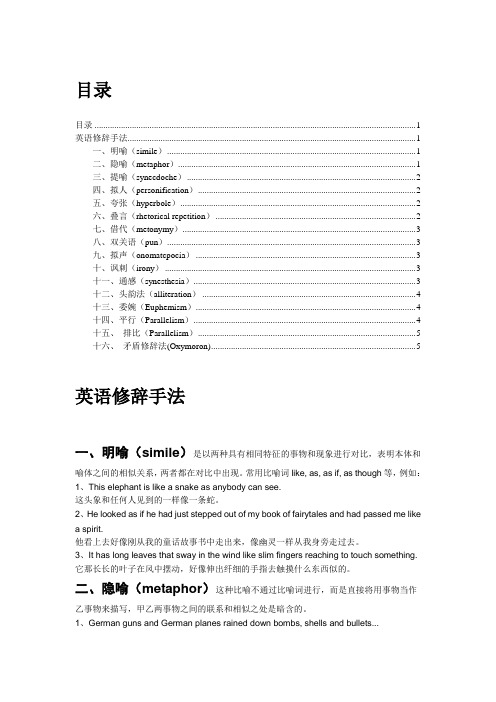
目录目录 (1)英语修辞手法 (1)一、明喻(simile) (1)二、隐喻(metaphor) (1)三、提喻(synecdoche) (2)四、拟人(personification) (2)五、夸张(hyperbole) (2)六、叠言(rhetorical repetition) (2)七、借代(metonymy) (3)八、双关语(pun) (3)九、拟声(onomatcpocia) (3)十、讽刺(irony) (3)十一、通感(synesthesia) (3)十二、头韵法(alliteration) (4)十三、委婉(Euphemism) (4)十四、平行(Parallelism) (4)十五、排比(Parallelism) (5)十六、矛盾修辞法(Oxymoron) (5)英语修辞手法一、明喻(simile)是以两种具有相同特征的事物和现象进行对比,表明本体和喻体之间的相似关系,两者都在对比中出现。
常用比喻词like, as, as if, as though等,例如:1、This elephant is like a snake as anybody can see.这头象和任何人见到的一样像一条蛇。
2、He looked as if he had just stepped out of my book of fairytales and had passed me likea spirit.他看上去好像刚从我的童话故事书中走出来,像幽灵一样从我身旁走过去。
3、It has long leaves that sway in the wind like slim fingers reaching to touch something. 它那长长的叶子在风中摆动,好像伸出纤细的手指去触摸什么东西似的。
二、隐喻(metaphor)这种比喻不通过比喻词进行,而是直接将用事物当作乙事物来描写,甲乙两事物之间的联系和相似之处是暗含的。
英语修辞方法总结

英语修辞手法总结英语中的修辞与汉语的修辞相比,分类细,种类多.下面将英语的修辞简单介绍如下:1.Simile 明喻明喻是将具有共性的不同事物作对比.这种共性存在于人们的心里,而不是事物的自然属性.标志词常用 like, as, seem, as if, as though, similar to, such as等.例如:1>.He was like a cock who thought the sun had risen to hear him crow.2>.I wandered lonely as a cloud.3>.Einstein only had a blanket on, as if he had just walked out of a fairy tale.2.Metaphor 隐喻,暗喻隐喻是简缩了的明喻,是将某一事物的名称用于另一事物,通过比较形成.例如:1>.Hope is a good breakfast, but it is a bad supper.2>.Some books are to be tasted, others swallowed, and some few to be chewed and digested.3.Metonymy 借喻,转喻借喻不直接说出所要说的事物,而使用另一个与之相关的事物名称.I.以容器代替内容,例如:1>.The kettle boils. 水开了.2>.The room sat silent. 全屋人安静地坐着.II.以资料.工具代替事物的名称,例如:Lend me your ears, please. 请听我说.III.以作者代替作品,例如:a complete Shakespeare 莎士比亚全集VI.以具体事物代替抽象概念,例如:I had the muscle, and they made money out of it. 我有力气,他们就用我的力气赚钱.4.Synecdoche 提喻提喻用部分代替全体,或用全体代替部分,或特殊代替一般.例如:1>.There are about 100 hands working in his factory.(部分代整体)他的厂里约有100名工人.2>.He is the Newton of this century.(特殊代一般)他是本世纪的牛顿.3>.The fox goes very well with your cap.(整体代部分)这狐皮围脖与你的帽子很相配.5.Synaesthesia 通感,联觉,移觉这种修辞法是以视.听.触.嗅.味等感觉直接描写事物.通感就是把不同感官的感觉沟通起来,借联想引起感觉转移,“以感觉写感觉”。
英语30种修辞手法
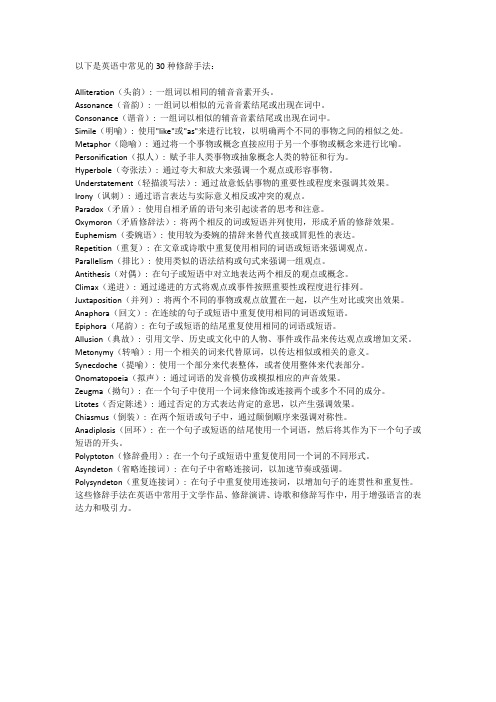
以下是英语中常见的30种修辞手法:Alliteration(头韵): 一组词以相同的辅音音素开头。
Assonance(音韵): 一组词以相似的元音音素结尾或出现在词中。
Consonance(谐音): 一组词以相似的辅音音素结尾或出现在词中。
Simile(明喻): 使用"like"或"as"来进行比较,以明确两个不同的事物之间的相似之处。
Metaphor(隐喻): 通过将一个事物或概念直接应用于另一个事物或概念来进行比喻。
Personification(拟人): 赋予非人类事物或抽象概念人类的特征和行为。
Hyperbole(夸张法): 通过夸大和放大来强调一个观点或形容事物。
Understatement(轻描淡写法): 通过故意低估事物的重要性或程度来强调其效果。
Irony(讽刺): 通过语言表达与实际意义相反或冲突的观点。
Paradox(矛盾): 使用自相矛盾的语句来引起读者的思考和注意。
Oxymoron(矛盾修辞法): 将两个相反的词或短语并列使用,形成矛盾的修辞效果。
Euphemism(委婉语): 使用较为委婉的措辞来替代直接或冒犯性的表达。
Repetition(重复): 在文章或诗歌中重复使用相同的词语或短语来强调观点。
Parallelism(排比): 使用类似的语法结构或句式来强调一组观点。
Antithesis(对偶): 在句子或短语中对立地表达两个相反的观点或概念。
Climax(递进): 通过递进的方式将观点或事件按照重要性或程度进行排列。
Juxtaposition(并列): 将两个不同的事物或观点放置在一起,以产生对比或突出效果。
Anaphora(回文): 在连续的句子或短语中重复使用相同的词语或短语。
Epiphora(尾韵): 在句子或短语的结尾重复使用相同的词语或短语。
Allusion(典故): 引用文学、历史或文化中的人物、事件或作品来传达观点或增加文采。
英语修辞法梳理
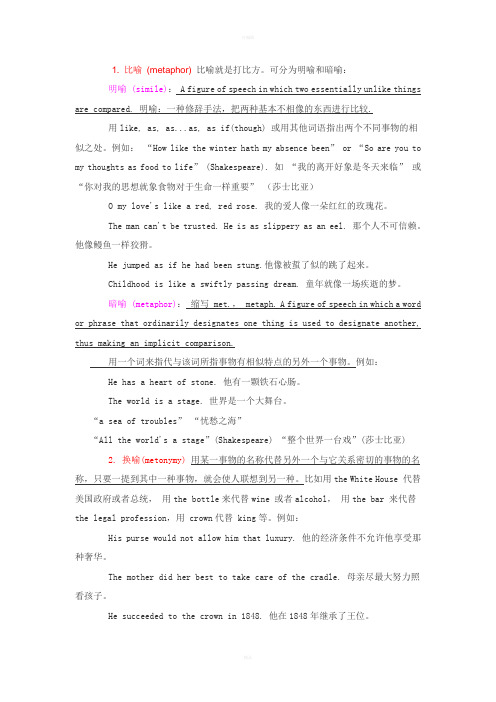
1. 比喻(metaphor)比喻就是打比方。
可分为明喻和暗喻:明喻 (simile): A figure of speech in which two essentially unlike things are compared. 明喻:一种修辞手法,把两种基本不相像的东西进行比较.用like, as, as...as, as if(though) 或用其他词语指出两个不同事物的相似之处。
例如:“How like the winter hath my absence been”or “So are you to my thoughts as food to life” (Shakespeare). 如“我的离开好象是冬天来临” 或“你对我的思想就象食物对于生命一样重要” (莎士比亚)O my love's like a red, red rose. 我的爱人像一朵红红的玫瑰花。
The man can't be trusted. He is as slippery as an eel. 那个人不可信赖。
他像鳗鱼一样狡猾。
He jumped as if he had been stung.他像被蜇了似的跳了起来。
Childhood is like a swiftly passing dream. 童年就像一场疾逝的梦。
暗喻 (metaphor):缩写 met., metaph. A figure of speech in which a word or phrase that ordinarily designates one thing is used to designate another, thus making an implicit comparison.用一个词来指代与该词所指事物有相似特点的另外一个事物。
例如:He has a heart of stone. 他有一颗铁石心肠。
英语的修辞手法 英语的45种修辞手法 定义 解释
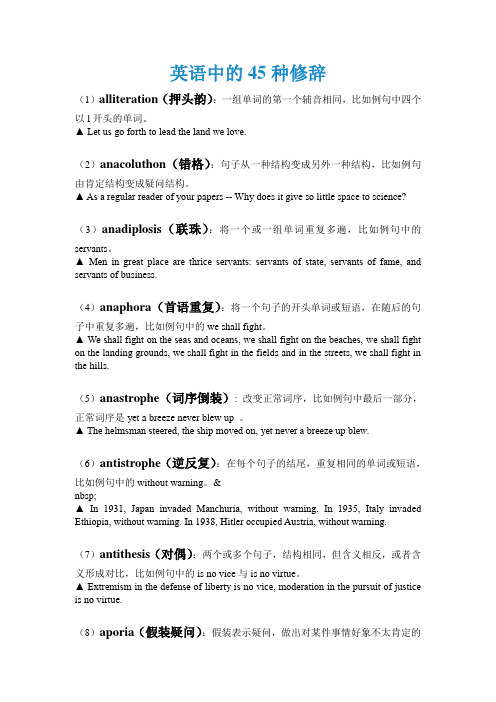
英语中的45种修辞(1)alliteration(押头韵):一组单词的第一个辅音相同,比如例句中四个以l开头的单词。
▲ Let us go forth to lead the land we love.(2)anacoluthon(错格):句子从一种结构变成另外一种结构,比如例句由肯定结构变成疑问结构。
▲ As a regular reader of your papers -- Why does it give so little space to science?(3)anadiplosis(联珠):将一个或一组单词重复多遍,比如例句中的servants。
▲ Men in great place are thrice servants: servants of state, servants of fame, and servants of business.(4)anaphora(首语重复):将一个句子的开头单词或短语,在随后的句子中重复多遍,比如例句中的we shall fight。
▲ We shall fight on the seas and oceans, we shall fight on the beaches, we shall fight on the landing grounds, we shall fight in the fields and in the streets, we shall fight in the hills.(5)anastrophe(词序倒装): 改变正常词序,比如例句中最后一部分,正常词序是yet a breeze never blew up 。
▲ The helmsman steered, the ship moved on, yet never a breeze up blew.(6)antistrophe(逆反复):在每个句子的结尾,重复相同的单词或短语,比如例句中的without warning。
- 1、下载文档前请自行甄别文档内容的完整性,平台不提供额外的编辑、内容补充、找答案等附加服务。
- 2、"仅部分预览"的文档,不可在线预览部分如存在完整性等问题,可反馈申请退款(可完整预览的文档不适用该条件!)。
- 3、如文档侵犯您的权益,请联系客服反馈,我们会尽快为您处理(人工客服工作时间:9:00-18:30)。
1明喻(simile)明喻是用来表达两种不同事物之间的相似关系,一般用like或as连接。
如:(1) O my luve is like a red,red roseThat’s newly sprung in June,O my luve is like a melodyThat’s sweetly played in tune.(Robert Burns)(2) The young hunter was as strong as a lion and as keen-eycd as an eagle.类似as…as的用法很普遍,有的成了习惯用语,如:as timid as a mouseas white as snowas black as pitchas busy as a beeEg.The man can't be trusted. He is as slippery as an eel. 那个人不可信赖。
他像鳗鱼一样狡猾。
He jumped as if he had been stung.他像被蜇了似的跳了起来。
Childhood is like a swiftly passing dream. 童年就像一场疾逝的梦。
1>.He was like a cock who thought the sun had risen to hear him crow.2>.I wandered lonely as a cloud.3>.Einstein only had a blanket on, as if he had just walked out of a fairy tale.2暗喻(metaphor)又称隐喻,暗喻的结构不同于明喻,没有as或like之类的比较关系词,它是隐含的比较。
英语词义通过暗喻方式可以产生转义:When the curtain fell,there was a storm of applause.He was so angry that he stormed about the house.暗喻多用to be结构来联系相比较的两个不同事物的:The society was his college.The guest is God of us.He is one of the dogs of the rich.Children are flowers of the motherland.Eg.He has a heart of stone. 他有一颗铁石心肠。
The world is a stage. 世界是一个大舞台。
3拟人(personification)比喻可以使无生命的事物具有生命,或者赋予动物以人性,从而造成某种意象或抒发某种情感。
如:an angry sky;the grave yawned;killinghalf-an-hour;the shoulder of the hill;the foot of the mountain;the dancing daffodils; the thirsty crops.Money talked as sweetly in Athens as it had in Chicago in the old days.(John Dos Passos)My heart was singing. 我的心在歌唱。
This time fate was smiling to him. 这一次命运朝他微笑了。
The flowers nodded to her while she passed. 当她经过的时候花儿向她点头致意。
The wind whistled through the trees. 风穿过树丛,树叶哗哗作响。
1>.The night gently lays her hand at our fevered heads.(把夜拟人化)2>.I was very happy and could hear the birds singing in the woods.(把鸟拟人化)转喻(metonymy) 转喻反映两个密切相关的事物的现实关系,转喻与明喻、暗喻不同,不需要两个事物相比,而是借用一个相关的事物代表本体。
因此,转喻是一种用另外一种事物的名称来代替某种事物名称的修辞手段。
如:The village rejoiced, 这里的village实际上喻指the people in the village.“转喻”的表现形式是很多的,在英语中常见的转喻有以下几种: 用一个事物来象征人或另一事物:to defy the crown(反抗君王)to be promoted to the bench(升为法官)用工具或器官来代替本体:The pen has more influence than the sword.He has an eye for beauty.Give every man thine ear,but few thy voice.用容器的各称来代替所盛的东西:They serve Chinese dishes.(中餐)The baby was brought up on the bottle.(喝牛奶或羊奶长大的)They chatted over a bottle.(边喝酒边聊天)The whole village came out to welcome the singers.(全村的人)用制造者的名字代表制成品:Do you like Schubert?I’ve never read Shakespeare.用地方代替事物:Kremlin(苏联政府)White House(美国政府)转喻可以收到言简意骇的修辞效果,给人以耳目一新的感觉,因而在诗歌中常常得以运用,从如下的诗句中我们可以感受到转喻的魅力:Sceptre and crown must tumble downAnd in the dust be equal madeWith the poor crooked scythe and spade.(J•Shirley)When from the cradle to the grave I look,Mine I conceive a melancholy book.(George Crabble,The Parish Register)Beneath the rule of men entirely greatThe pen is mightier than the sword.(Edward George Bulwer-Lytton,Richelieu)The camp,the pulpt and the lawFor rich men’s sons are free.(Percy Bysshe Shelley)在诗歌中,还有一种转喻式的“转换形容词”,这是维吉尔、斯宾塞、弥尔顿、格雷等古典派艺术诗人作品中一种文体上的特色:“Sansfoys dead dowry”(意为“死去的圣斯伏依的嫁妆”)中将形容词的dead从占有者(Sansfoys)转到被占有的东西上(dowry—嫁妆)。
在格雷的“dro wsy tinkling”(“昏昏欲睡的叮铃声”)和弥尔顿的“merry bells”(“欢乐的铃”)中,形容的实际上分别指佩铃的人和敲铃的人。
在弥尔顿的牛绳在“吹着她闷热的号角”(“winding her sultry hern”)一句中,形容词形容的是闷热的夏季黄昏,这种情形乃是由牛绳发出的嗡嗡声联想而来的。
所有这些从上下文中摘出的例子,似乎都可以从万物有灵论的角度去阅读,关键是联想的逻辑是否起作用。
虔诚的宗教诗多采用隐喻式的比喻。
但新古典主义赞美诗的作者瓦茨(I.Watts)博士则采用转喻而获得了感人的、庄严的效果:When I survey the wondrous crossOn which the Prince of Glory died,My richest gain I count but lossAnd pour contempt on all my pride.See,form his head, his hands,his sideSorrow and love flow mingled down;Did ever such love and sorrow meetOr thorns compose so rich a crown?(当我审视这奇妙的十字架光荣的王子死在那上边,我把最丰富的收获只当做损失用轻蔑浇灭我全部的傲慢。
看吧,从他的头,他的手,他的两侧混合流下的是哀愁和哀怜;这种爱和哀愁从前可曾合流或者荆棘曾编织过如此华美的皇冠?)“sorrow”与“love”等用于“water”和“blood”, 他为爱而死,他的爱是因,流血是果。
His purse would not allow him that luxury. 他的经济条件不允许他享受那种奢华。
The mother did her best to take care of the cradle. 母亲尽最大努力照看孩子。
He succeeded to the crown in 1848. 他在1848年继承了王位。
提喻(synecdche)提喻也是不直接说某一事物的名称,而是借事物本身所呈现的各种对应的现象来表现。
提喻与转喻不同,转喻主要借助于密切的关系与联想,而提喻则是借助于部分相似。
转喻通常是借助于密切的关系与联想,而提喻则是借助于部分相似。
提喻通常是局部来代替整体,间或也用整体来代替局部,局部与整体之间总有相似之处。
英语词义的扩大也有通过提喻这一演变方式的,如有些词从特指扩大到一般:journal从“日报”发展到指一切“期刊”;有些词义从具体扩大到抽象,或从抽象扩大到具体:grasp从具体的“用手抓住”发展扩大为抽象的“用头脑去掌握、领会”;youth不只是抽象名词表示“年轻、青春(状态或阶段)”,在古英语中就已经可以作集合名词指“青年人”这一整体。
有的词义从专有名词扩大到普通名词:用科学家的名字watt来命名物理学的单位;此外象paper 来自papyrus(纸草,做纸的原料)也是词义通过提喻方式演变的例子。
常见的提喻有如下几种:1. 用局部代替整体:Many hands make light work. (用hand表示干活的人)The case was defended by eloquent lips.(用lips表示有辩才的人)They came to live under the same roof.(用roof表示整个房子)2. 用整体代替局部:China won the volleyball match.(用China代表中国队)3>.The fox goes very well with your cap.(整体代部分)这狐皮围脖与你的帽子很相配.3. 用个体代替整个一类:She is another Madam Curie.4. 用具体代替抽象:The father yearns in the p rince’s breast.(Dryden)5. 用抽象代替具体:The authorities(当局)6. 用材料代替事物:a piggy-bank full of coppersEg.He earns his bread by writing. 他靠写作挣钱谋生。
